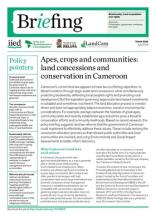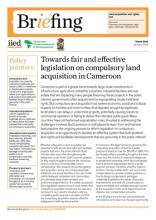Land Library Search
Through our robust search engine, you can search for any item of the over 73,000 highly curated resources in the Land Library.
If you would like to find an overview of what is possible, feel free to peruse the Search Guide.
/ library resources
Showing items 1 through 9 of 215.Land in Cameroon is under growing pressure for many reasons — powerful commercial interests, changing climate conditions and shifting demographic flows including mass migration and increasing population density.
Cameroon’s current land law appears to have two conflicting objectives: to attract investors through large-scale land concessions while simultaneously protecting biodiversity, defending local people’s rights and promoting rural development.
Cameroon is part of a global trend towards large-scale investments in infrastructure, agriculture, extractive industries, industrial facilities and real estate that are displacing many people.
From the mid-2000s, a commodity boom underpinned a wave of land use investments in low- and middle-income countries.
This article reflects on the Tenure Guidelines as a tool for addressing resource governance challenges.
The researchers have used evidence from Mato Grosso, Brazil, to show that changes in agricultural output stemming from the sensitivity of cropland area and cropping frequency to interannual climate variability are of similar magnitude to agricultural output changes associated with the sensitivity
The report's main objective is to provide key lessons from the sustainable urban tourism project through the analysis of different enabling conditions and obstacles that determined the course and the final outcome of the initiative.
The purpose of this study was to determine the financial cost of irrigation water in the Jordan Valley and the corresponding impact of higher water prices on farming. The analysis shows that JVA needs significant tariff increases to be able to attain a more financially sustainable footing.
Results demonstrate that the effects of management on cropland can be beneficial for carbon and nutrient retention without risking (large) yield losses.






